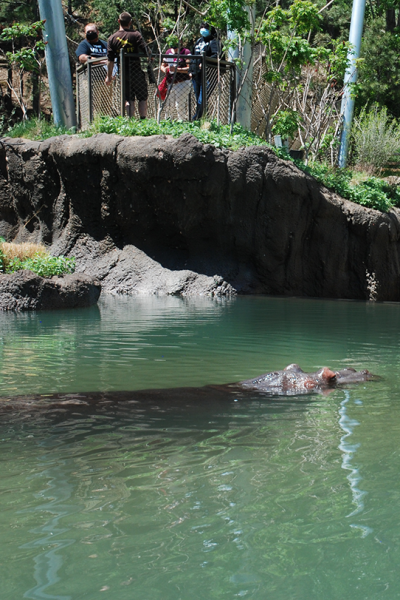Cheyenne Mountain Zoo welcomed another multi-ton resident to the brand-new exhibit, Water’s Edge: Africa, on Tuesday evening. Biko (BEE-koh), a 17-year-old male Nile hippopotamus, will join female hippos, Zambezi (zam-BEE-zee) and Kasai (kuh-SIGH), on a breeding recommendation from the Association of Zoos and Aquariums’ (AZA) Nile Hippopotamus Species Survival Plan.
He will continue to acclimate to his new home and complete a routine quarantine period. Then, keepers will begin the process of introducing him to the female hippos. If successful, this would be the first time any of the three hippos produced offspring.
Only 30 of the 233 organizations accredited by the AZA in North America house hippos. The last male hippo who lived at Cheyenne Mountain Zoo was Tony, who passed away in 1989. Although our female hippos first came to CMZoo decades ago, this is the first attempt to breed hippos at the Zoo in more than 30 years.
Since Zambezi and Kasai returned to Cheyenne Mountain Zoo from Dickerson Park Zoo, an AZA-accredited zoo in Springfield, Missouri, on May 22, 2020, they have taken turns sharing space and showing their keepers they would sometimes rather be in separate spaces. The hippo pools, yards and indoor beach areas in Water’s Edge: Africa were designed to accommodate separation for various pods formed by the hippos and their potential future offspring.
“We’ve been working on letting the girls spend time together until they show us they’d prefer a little time apart,” said Patty Wallace, senior lead keeper at Water’s Edge: Africa. “They’re spending more and more time together, but still seem to want time away from each other to appear totally comfortable in their new home. With the arrival of Biko, who is smaller than the females, the dynamics could completely change. Only time will tell. We will watch their behavior closely, and let them tell us what the next steps are.”
Biko came to Cheyenne Mountain Zoo from an AZA-accredited institution in central Florida on a breeding recommendation with both Zambezi and Kasai, who are 27 and 20 years old, respectively. Once Biko has cleared quarantine, the hippo keeper team will use a variety of underwater and above-ground gates to give the hippos opportunities to have their own spaces and also participate in ‘howdies,’ which are introductions with barriers between the animals. This allows the animals to smell, see and approach each other without risking injury.
“We always look for signs that the animals are confident during ‘howdies,’” said Wallace. “If they show us they feel uncomfortable, we help them see that they are in control by giving them the choice to walk away. They are always making the choice to interact with another animal or not. If we see signs that the two animals are comfortable and confident with each other, we move on to introductions in a shared space, usually for small increments of time that increase slowly.”
The International Union for Conservation of Nature (IUCN) Red List categorizes Nile hippopotamuses as a species vulnerable to extinction in the wild, estimating less than 150,000 remain in their native habitats. Their primary threats are habitat loss and illegal and unregulated hunting. Hippos are hunted for ivory, which is found in hippopotamuses’ canine teeth, and meat.
After Biko clears quarantine, guests will be able to see him at Water’s Edge: Africa, which is now home to three hippos, 11 African penguins, two common warthogs, three ring-tailed lemurs and roughly 30 guinea pigs. The design of the exhibit removes as many barriers as safely possible between guests and the animals, including the outdoor penguin beach that gives penguins access to waddle right up to guests. The outdoor hippo space features a knife-edge pool that puts guests eye-to-eye with the hippos, overlooked by lemur island – an outdoor/indoor space for lemurs to climb high onto trees with incredible views of Colorado Springs. Encouraging guests to participate in nature play, the exhibit also features a nature trail with natural obstacles like a log forest and boulder area, perfect for testing your traversing skills. The nature trail leads to a one-of-a-kind rope suspension bridge that leads guests over the outdoor hippo yard, for up-close overhead views of hippos unavailable anywhere else in the world.
About Cheyenne Mountain Zoo
Cheyenne Mountain Zoological Society was founded in 1926. Today, Cheyenne Mountain Zoo, America’s mountain Zoo, offers comprehensive education programs, exciting conservation efforts and truly fantastic animal experiences. In 2019, Cheyenne Mountain Zoo was voted #6 Best Zoo in North America and CMZoo’s Rocky Mountain Wild was named #5 Best Zoo Exhibit in North America by USA TODAY 10Best Readers’ Choice Awards. It is Cheyenne Mountain Zoo’s goal to help guests fall in love with animals and nature, and take action to protect them. Of the 233 zoos and aquariums accredited by the Association of Zoos and Aquariums (AZA), Cheyenne Mountain Zoo is one of just a few operating without tax support. Cheyenne Mountain Zoo depends on admissions, membership dues, special event attendance and donations for funding.

